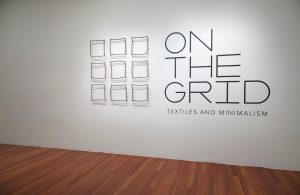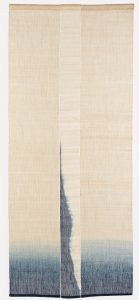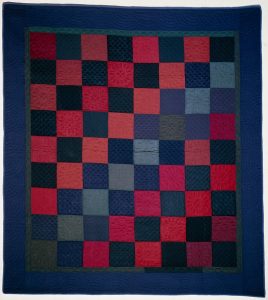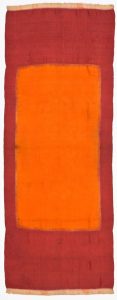The current exhibit at the M.H. deYoung Museum in San Francisco’s Golden Gate Park speaks to weavers in many ways. The theme of the exhibit is comparing these weavings to the Minimalism school of abstract art. There is the repetition of simple forms, grids, and symmetrical regular geometric forms. The use of stripes can be seen in many of these woven pieces. There are more than 24 textiles in the exhibit that show us how simplicity of design ties these pieces to the principles of Minimalist Art.
At the entrance of the exhibit is Laura’s Quilt by Gyongy Laky.

Laura’s Quilt by Gyongy Laky
Of particular interest to weavers should be the three weavings that are hung so both sides are visible:
Wrapping cloth (pojagi) from Korea woven with bast fiber
Soto Zen Buddist’s Priest Robe (kesa) from Japan woven with bast fiber (ramie or hemp)
Breast cloth (Kamben cerek or wastra tirtanadi) 20th Century, Indonesia, Bali. Cotton, plain weave, spaced warp, discontinuous weft.
A favorite of mine is the weaving by Hiroyuki Shindo “Untitled”, cotton, silk, linen, plain weave, dip dyed most probably in indigo.

Untitled by Hiroyuki Shindo
Rebecca R. Medel has produced a four layer knotted netting with double ikat dyeing in both warp and weft that is impressive.
An Amish quilt in cotton and wool is a familiar example of the repetition of simple forms. A cotton coverlet is an example of Op Art, ca. 1960, woven in double weave.

Amish Quilt Checkerboard pattern circa 1900
All of these weavings are from the Museums’ permanent collection. They cover the world: United States; Melanesia, Solomon Islands, Santa Cruz Islands; Peru, South, Acora region, Aymara and Moquegua, Ubinas, Aymara; Indonesia, Palembang, Sumatra; Japan. For example there is a men’s mantle as well as a ceremonial shawl from Peru. We see an apron panel from Tibet, a woman’s tunic (phyang) from Burma and a woman’s head cover from Morocco. Looking at the married woman’s shoulder cloth (lawon) from Sumatra I was reminded of the art of Mark Rothko .

Married woman’s cloth(lawon)
The exhibit is in the Wais and Knowles Galleries of Textile Arts through February 12, 2017 .
Marlene learned to weave over thirty-five years ago at the City College of SF classes which were held at Ft. Mason. Most of that time she wove on 4 – 8 shafts. After retiring 15 years ago, she “graduated”, first to a 16 shaft loom and then to a 24 shaft loom.
Click here for the next article.